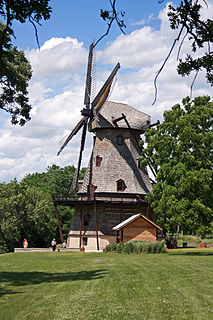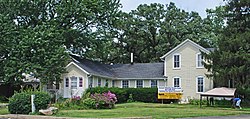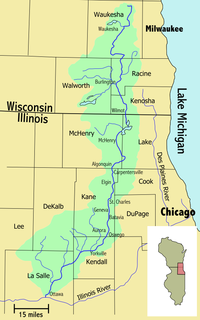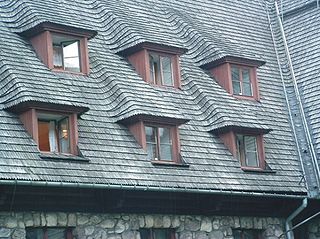
A motel or motor lodge is a hotel designed for motorists and usually has a parking area for motor vehicles. Entering dictionaries after World War II, the word motel, coined as a portmanteau contraction of "motor hotel", originates from the Milestone Mo-Tel of San Luis Obispo, California, which was built in 1925. The term referred initially to a type of hotel consisting of a single building of connected rooms whose doors faced a parking lot and in some circumstances, a common area or a series of small cabins with common parking. Motels are often individually owned, though motel chains do exist.

Stuckey's is a roadside convenience store chain found on highways throughout the United States. Stores are concentrated in the Southeast, Southwest, and Midwest, although operations have existed as far east as Connecticut and as far west as Oregon. Stuckey's Corporation, the company operating the chains, has its headquarters in Eastman, Georgia.

The Spencer–Peirce–Little Farm is a Colonial American farm located at 5 Little's Lane, Newbury, Massachusetts, United States, in the midst of 231 acres (93 ha) of open land bordering the Merrimack River and Plum Island Sound. The farmhouse, dating to c. 1690, was designated a National Historic Landmark in 1968 as an extremely rare 17th-century stone house in New England. It is now a nonprofit museum owned and operated by Historic New England and open to the public several days a week during the warmer months; an admission fee is charged for non Members.
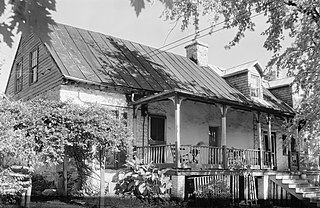
White House Farm, also known as White House Tavern and the Dr. John McCormick House, listed in the National Register of Historic Places, is located in Jefferson County, West Virginia, near the small town of Summit Point, about six miles from Charles Town, West Virginia. The farm consists of a ca. 1740 farmhouse, a stone barn, a springhouse of about the same age, a wooden curing shed, and 60+ acres of pasture and woods. The farm is one of the oldest in the county and has a rich history.
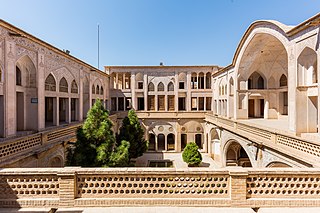
The Abbāsi House is a large historic house museum in Kashan, Iran. It was built during the late 18th century and belonged to a wealthy glass merchant. It is partly converted into a teahouse, a traditional restaurant, and a small shop. Other such houses, including the Borujerdi House and the Tabātabāei House, are located nearby.

A teahouse or tearoom is an establishment which primarily serves tea and other light refreshments. A tea room may be a room set aside in a hotel especially for serving afternoon tea, or may be an establishment which only serves cream teas. Although the function of a tearoom may vary according to the circumstance or country, teahouses often serve as centers of social interaction, like coffeehouses.

U.S. Route 66 was a United States Numbered Highway in Illinois that connected St. Louis, Missouri, and Chicago, Illinois. The highway had previously been Illinois Route 4 (IL 4) and the road has now been largely replaced with Interstate 55 (I-55). Parts of the road still carry traffic and six separate portions of the roadbed have been listed on the National Register of Historic Places.
White Fence Farm is the name of a restaurant chain with locations in the Chicago metropolitan area. The original location is in Romeoville, Illinois.

The Vanderbilt Lane Historic District is a small area along the street of the same name, just east of US 9 in Hyde Park, New York, United States. It was used for the farm functions of the nearby estate of Walter Langdon and, later, Frederick Vanderbilt. Most of its buildings date to the turn of the 20th century, with one remaining from the 1830s.

Sukiya-zukuri (数寄屋造り) is one type of Japanese residential architectural style. Suki means refined, well cultivated taste and delight in elegant pursuits and refers to enjoyment of the exquisitely performed tea ceremony.
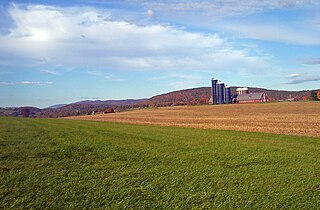
The Coleman Station Historic District is located around the former New York Central Railroad Coleman's station in the Town of North East, New York, United States, a short distance south of the village of Millerton. It is a rural area including several large farms in the southeastern corner of the town. At almost three square miles (7.33 km2), it is the largest historic district entirely within Dutchess County and the second largest in the county.

Prairie Farms Dairy is a dairy cooperative founded in Carlinville, Illinois, and headquartered 35 miles to the south in Edwardsville, Illinois, a suburb within Greater St. Louis. As a dairy cooperative, Prairie Farms receives milk from producers and converts it into many different products, including cheese, butter, ice cream, sour cream, cottage cheese, various dips, yogurt, and fluid milk. Prairie Farms also produces and sells juices, flavored drinks, and pre-made iced tea.

The Harland Sanders Café is a historic restaurant located in Corbin, Kentucky. Colonel Harland Sanders, the founder of Kentucky Fried Chicken, operated the restaurant from 1940 to 1956. Sanders also developed the famous KFC secret recipe at the café during the 1940s. It was added to the National Register of Historic Places on August 7, 1990.

The Lakeview Tithing Office, also known as the Bunnell Creamery, is a historic building located in Provo, Utah, United States. It is listed on the National Register of Historic Places.

Christian Habeck Farm, also known as the Abraham Brubaker Farm, is a historic farm and national historic district located at East Hempfield Township, Lancaster County, Pennsylvania. The district includes 12 contributing buildings. They include the brick farmhouse, a frame Pennsylvania bank barn (1869), spring house, two frame tobacco barns, a brick tenant house, a summer kitchen, a pigsty, a milk house, and a creamery. The farmhouse dates to the mid-to-late-19th century. It is a 2 1/2-story, rectangular brick dwelling, with a full-width front porch.
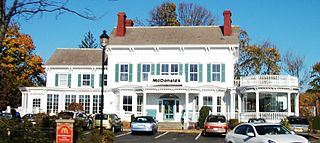
The Denton House is a historic building in New Hyde Park, New York, within the Town of North Hempstead. Built in 1795 as a farmhouse, it was converted in the 1860s to a Georgian-style mansion. It is currently a McDonald's restaurant.
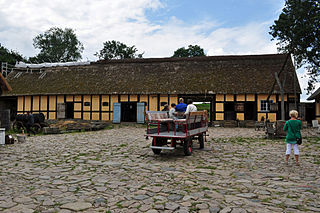
Melstedgård, also known as Bornholms Landbrugsmuseum, is an old farm 3 kilometres (1.9 mi) west of Svaneke on the Danish island of Bornholm. Built in 1801, the half-timbered farmhouse now serves as the centre of a farming museum. One of its main attractions is the windmill, Tejn Mølle, which opened in 2009.
Whittington is a civil parish in Lancaster, Lancashire, England. It contains 39 buildings that are recorded in the National Heritage List for England as designated listed buildings. Of these, three are at Grade II*, the middle grade, and the others are at Grade II, the lowest grade. The parish contains the villages of Whittington, Docker and Newton, and is otherwise rural. Most of the listed buildings are country houses with associated structures, smaller houses, and farm buildings. The other listed buildings include a church with a sundial in the churchyard, buildings on a model farm, three milestones, a boundary stone, and a former school.
Thornley-with-Wheatley is a civil parish in Ribble Valley, Lancashire, England. It contains nine listed buildings that are recorded in the National Heritage List for England. All of the listed buildings are designated at Grade II, the lowest of the three grades, which is applied to "buildings of national importance and special interest". The parish is entirely rural, and most of the listed buildings are farmhouses and farm buildings. The other listed buildings are a house, a church and presbytery, and a mounting block.
Teeswater Creamery is a dairy business in the town of Teeswater, Ontario, Canada. It is the oldest creamery in Ontario. Since 1981 it has been owned by the Gay Lea Foods Co-operative.

